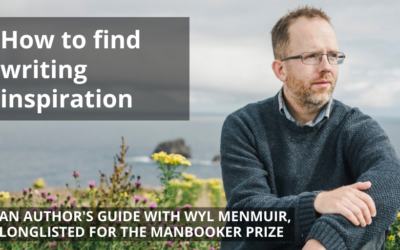Writing advice is confusing. There’s no one sure-fire approach to productivity – there are many, and to make it worse writing tips are often contradictory and damn right conflicting. So, whether you want to go large or small, stick or quit, single or multi-task – try one of these tips. Then do the complete opposite.
1. Stick or quit?
You’ve got the time and a place to write, but nothing happens. No words. Nothing. Just that empty screen staring back at you. Do you stick? Or do you quit?
Try this: Freewriting
When we ask writers how they feel when they write, 9 times out of 10 they’re more positive after a session, however negative and despairing they were to begin with. So get that session started!
Take a tip from research* and try freewriting to overcome your blocks. You need to conquer your fear of the blank page and get some words down, even bad ones, to get started.
“Start writing, no matter what. The water does not flow until the faucet is turned on.” Louis L’Amour
If it’s really not working, run an experiment to test what’s going on, it might be that you are genuinely too tired and uninspired. Set yourself a timer for 10 minutes then check in. Are you able to write? Yes – then carry on.
Try the opposite: Quit writing
If you’ve run a test and found that you cannot write, then that’s your signal to stop and finish the session. Don’t force it. You’ve tried your best so you can step away from your project guilt-free and go and do something else.
Ernest Hemingway, Robert Cialdini and Naomi Alderman have all used quitting to their advantage. They quit when still on a roll, often in the middle of a sentence. They were tapping into something called The Zeigarnik effect where people remember uncompleted or interrupted tasks better than completed ones because their attention is drawn to them.
“I always stopped when I knew what was going to happen next. That way I could be sure of going on the next day.” Ernest Hemingway
Quitting before the end of a session keeps momentum going long term. The trick is to quit before you’re ready – don’t wait until you’re tired as you’ll be past your best.
Instead, stop when you feel most able to continue your writing. Resist the urge to continue. However hard it is, do not to go back your desk, but keep those interrupted ideas mulling over until your next session.
2. Reward or punishment?
One writer’s pleasure is another one’s pain. Literally – some writers keep themselves writing with a steady stream of treats while others keep on their toes with the ever-present threat of punishment. Both have found a way to motivate themselves and both are right.
Try this: Keep your eyes on the prize
The promise of a prize drives some writers forward. It inspires them to start and keeps them motivated to continue.
Start with a small incentive to treat yourself at the end of a session. I often write first thing in the morning with breakfast to reward me on the other side. Increase your reward level to match the time and effort. I booked myself a holiday to coincide with the deadline of finishing the first draft of my book. It was a big incentive, and as the deadline drew closer it gave me an extra push to complete.
“When we give ourselves treats, we feel energized, cared for, and contented, which boosts our self-command – and self-command helps us maintain our healthy habits.” Gretchen Rubin
Try the opposite: Punish yourself
If pleasure isn’t the thing to get you writing, then perhaps you need some pain.
Behavioural scientists have found that ‘loss aversion’ to be a more powerful motivator than the promise of gains. In short, many of us would rather not lose something than gain something. Take my pre-booked holiday – the thought of cancelling it kept me going until that draft was finished.
Make use if this powerful force for action with StickK a website set up by economists where you place a wager to complete a goal or Write or Die which deletes your words if you pause.
>> Read more: How to keep writing using rewards
3. Positive or negative thinking?
Neuroscience shows that when you visualise something you stimulate the same parts of the brain as when you actually do it, activating lots of brain chemicals and creating new neural pathways. This is the case for both positive and negative visualisation.
Try this: Visualise success
If you want to trigger your upbeat writing brain – write a list of at 10, 20, perhaps 50 positive things that will happen when you achieve your writing goal. Time travel to the future and imagine triumph, the best possible outcome, how you’ll celebrate, and all the things that went well.
Get creative and draw a picture of your writing dreams and goals. It will embed the message deeper and help you retain it more clearly and for longer.
Then put in place a plan that makes it more likely for all the great stuff to happen.
>> Read more: Say it, write it, draw it – 8 visualising exercises for writers
Try the opposite: Visualise failure with a pre-mortem
Before we get all Pollyanna with our perfectly imagined futures, let’s consider failure. The practice of anticipating obstacles dates back to ancient Roman philosopher Seneca and is a core element of Stoic teaching. The idea is to imagine what can go wrong, and rehearse how you deal with it.
“Nothing happens to the wise man against his expectation.” Seneca
Scientist Gary Klein calls this a ‘pre-mortem’ and advises teams to create a blueprint for failure. In a kickoff meeting, a project team should review their plans, imagining they are six months in the future and that everything that could go wrong has gone wrong. By predicting disaster they can build contingencies into the plans and increase the chance of success.
Doing this with your writing helps you prepare emotionally and practically with setbacks.
4. Go small or go large?
Does a big writing project get you all fired up or full of fear? Figure out whether to start small or challenge yourself.
Try this: Start small
When we consider big goals such as writing a book, it triggers our amygdala – the brain’s natural defence mechanism – into taking fright. By focusing on small tasks, we can bypass the body’s fear system and begin to make progress.
Brainstorm or mindmap some starter steps. These are small tasks that get you going, for example, opening your notebook or naming a document. It’s by keeping the bar low you’ll begin a routine. Over time you’ll increase how often, how long, or how many words you write as you scale up to achieve your goal.
“Accomplish the great task by a series of small acts.” Tao Te Ching
Try the opposite: Challenge yourself
Challenges motivate us to stretch ourselves beyond what we’re capable of. For some writers small just stalls them – they need to go large to get going.
Set a target just beyond your comfort zone. It might be the infamous Big Hairy Audacious Goal, for others it might be a practice such as maintaining a writing streak for as long as possible, or writing many words in a big splurge.
Having an ambitious goal can be an incredible motivator, so challenge yourself like the hundreds of thousands who sign up to NaNoWriMo to write a 50,000-word novel in November.
>> Read more: How to set a writing goal: the ultimate guide
5. Single-task or multi-task?
Focus is a superpower in today’s world of distraction, but is it better for you to keep a tight focus on a solitary goal or juggle many?
Try this: Single task
Research shows that multi-tasking has a significant impact on productivity – one 1997 study on cognitive processes and multiple-task performance found that shifting between tasks can cost as much as 40% of someone’s productive time.
Psychologists have found that doing two tasks at the same time slows down completion time and reduces accuracy. There’s also ‘switching costs’ including the time it takes to refocus – a University of California Irvine study found it takes 23 minutes and 15 seconds to get back on task.
Other research shows multi-tasking lowers your IQ, impacts short-term memory, increases anxiety, and stops you getting into a state of flow. It looks like single-taskers have won the argument.
Try the opposite: Slow motion multi-tasking
Not so fast says Tim Harford in his TED Talk on ‘slow motion multi-tasking’. He urges us to embrace the counter-intuitive position of having several interests that can occupy us across many years, perhaps a whole lifetime – a practice used by many Nobel Prize winners.
It isn’t the concentration-destroying toggling between open tabs, emails, calls and documents, which according to Harford we lapse into “out of desperation.”
“If we were willing to slow multi-tasking down, we might find that it works quite brilliantly.” Tim Harford
What opposites are you willing to try?
There is no one way to write, there are many. As we say, productivity is personal – you just need to figure out what works for you, right now – not in the past or in some perfect imagined future.
Experiment with new techniques. Try a new writing approach, if works brilliantly – double down on it. And if it fails, then try the opposite.
*Robert Boice, Procrastination, busyness and bingeing, Behaviour Research and Therapy, Volume 27, Issue 6, 1989, Pages 605-611
[et_bloom_inline optin_id=optin_7]




